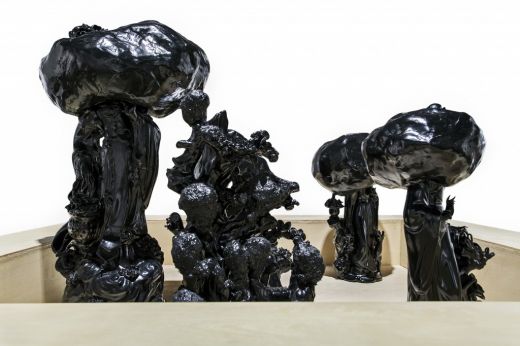
Susan Lee-Chun, Untitled, (2013); mixed media; dimensions variable.
April 5 – May 10, 2014
The title of the group exhibition at David Castillo Gallery, Metabolic Bodies, implies that the strategy of using manipulated readymades is a corporeal action, a chemical change that transforms a substance (in this case found images or objects) into energy. Some of the works in this materially diverse exhibition accomplish that goal more adroitly than others; the most successful are the works in which the original material is not wholly consumed by the process of transformation—that is, they assert an ongoing dynamic state.
For example, Susan Lee-Chun’s “Untitled” (2013) black-painted statues of Asian deities feature both an immediately recognizable initial form—gift-shop idols of Kwan Yin and other figures—and a distinctly transformative addition: bulbous masses that occupy the heads of each effigy. They stand en masse atop a mid-height plinth, yet each is swallowed up by a cancerous growth that obscures the goddesses’ own sight and identity. The resulting forms hover between marketplace Orientalist kitsch and the grotesque.
Another work that productively explores this tension between a repurposed object and its transformative additions is Sanford Biggers’ “Quilt 16” (2013). Biggers adorns a queen-sized, hand-stitched quilt with acrylic and spray paint. There is a marked friction derived not only from the juxtaposition of the precisely crafted bedcover with the messiness of the spray paint, but also from the imagery: a bucolic plantation house set in a formal flower-adorned garden is lovingly rendered in embroidery, yet painted additions depicting the clouds of heaven and the fires of hell encroach upon the space above and below the mansion. To further heighten this dissonance, Biggers has hung the work so that the house is upside-down, reversing not just the image, but the very polarity of the readymade. The appropriated quilt is not fully dominated by the artist’s additions; it exists as a foil and a source of vitality and intensity not found in the original article.
Other works are not as efficacious in achieving this potent dialectic. Robert Melee’s “Untitled” (2012) work is brightly cheerful, but the bottle caps that function as a substrate for thick layers of paint are thoroughly obscured. Adler Guerrier’s “Untitled” (2012), a suite of four suburban landscape C-prints, fall flat when considered in the light of the curatorial premise. These works seem already metabolized, existing in a state of complete post-consumption.
The standout work in the exhibition is the unexpected combination presented by Quisqueya Henriquez in “Carmen Herrera Inside Popova” (2013). A framed reproduction of Herrera’s work is nestled within another frame containing an original printed pattern by Lyubov Popova. This begs the question of which print is being devoured: do the scale and coloration of Popova’s energetic patterns overwhelm the black-and-white Herrera; or does the Herrera, placed in front, interrupt and obscure the Popova? The combination of asymmetry and impeccable rhythm, united by the pristine white framing, begets a cleverly taut dynamic falling somewhere between discord and harmony.










